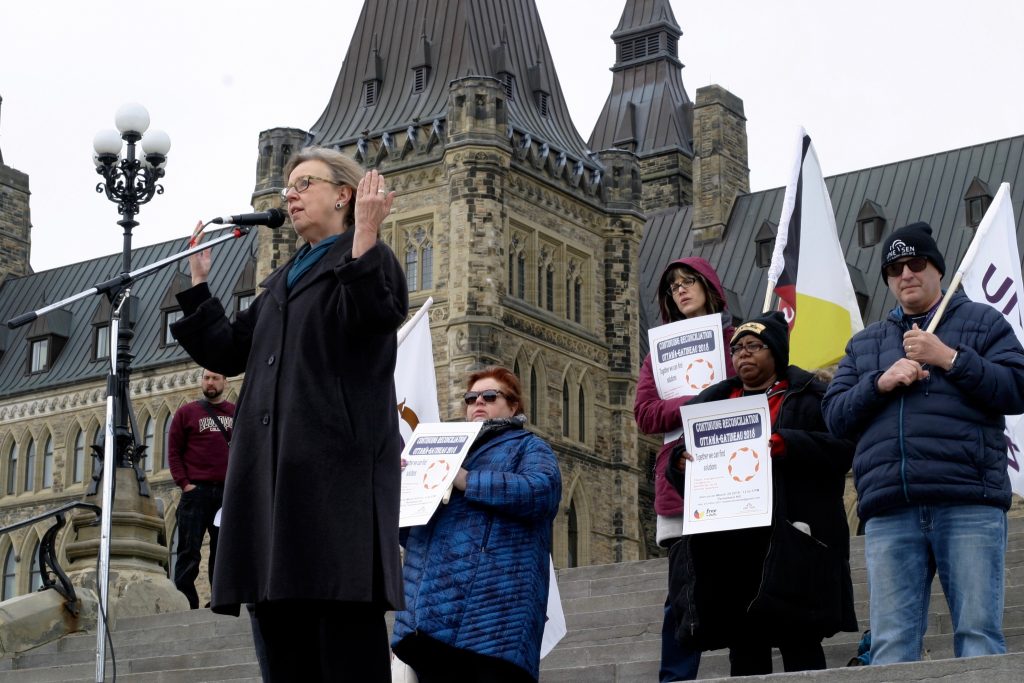Rally calls for stronger efforts at reconciliation with Algonquin First Nations
By Allison Gram
Indigenous, religious, union and political leaders from across Ottawa gathered on the steps of Parliament Hill on March 29 in a passionate call for stronger efforts at reconciliation for the Algonquin Anishinaabe First Nations.
“I’m not used to walking on this cement. It hurts my feet,” said Anishinaabe Elder Rose Wawatie Beaudoin. “I’d rather walk on grass, where it’s soft, where I can feel Mother Earth, and every step I take, I feel her. And for me, I am very proud to be Anishinaabe of this unceded Algonquin territory.”
The gathering was organized by Free the Falls, a group of Indigenous and non-Indigenous people who advocate for a green and non-commercial vision for Chaudière Falls — an important Ottawa River spiritual centre for local Anishinaabe people — and the surrounding islands in the northwest corner of Centretown.
Development around Chaudière Falls — which now houses a hydroelectric dam and set to be surrounded by the massive ZIBI commercial-residential real estate project — is one of many concerns raised by the Indigenous people of the Ottawa area.
“I honour you and I raise my hands to you,” said federal Green Party leader Elizabeth May, lifting her arms, palms turned inwards, as a gesture of respect to the crowd of about 30 gathered on Parliament Hill.
May addressed “settler culture Canadians” in her speech, calling upon them to engage in a “multi-generational commitment” to restore respectful relationships with the Indigenous people.
For a number of Algonquin Anishinaabe people living in Ottawa, the city doesn’t feel like home.
One of those individuals, Michel Lacroix, is a board member with the Odawa Native Friendship Centre, currently located at the City Centre complex near LeBreton Flats. He said that the first step to make Ottawa feel like home to Indigenous youth is to have a gathering place like the friendship centre.
But Lacroix said he’s disheartened that in October, the ONFC will no longer have its current space.
“With the hockey arenas being built, the disaster happening at Chaudière, and all the fighting, really, I’d pray to see a building where people can feel at home and people can learn from Indigenous cultures — not just in a museum,” he said.
Peter Stockdale, an activist with Free the Falls, said there has been a lot of discussion with the Liberal government on the topic of reconciliation and some movement forward.
“But turning around the ship after 150 years of exclusion and destruction of Indigenous people is a hard ship to turn around. And the government has been trying but they can do a lot more,” he said.
In June 2015, after the Truth and Reconciliation Commission report was published but before the 2015 federal election, the then-campaigning Liberal leader Justin Trudeau promised to implement all 94 Calls to Action outlined in the document.
Beyond 94 is a website published by the CBC last month to monitor the government’s progress on the Calls to Action. Just 10 of 94 Calls to Action have been accomplished as of March 2018, according to the website.
For many Indigenous people and their supporters, the government needs to take more immediate action.
“We can think about something, make pronouncements and promises, we can have and state our best intentions,” said Rev. Anthony Bailey of Parkdale United Church. “But if our feet are not walking in the ways of partnership and justice and concrete, respectful, restorative action with our Indigenous brothers and sisters then all those promises, all those pronouncements, all those apologies and commitments just seem like lies and insults.”

